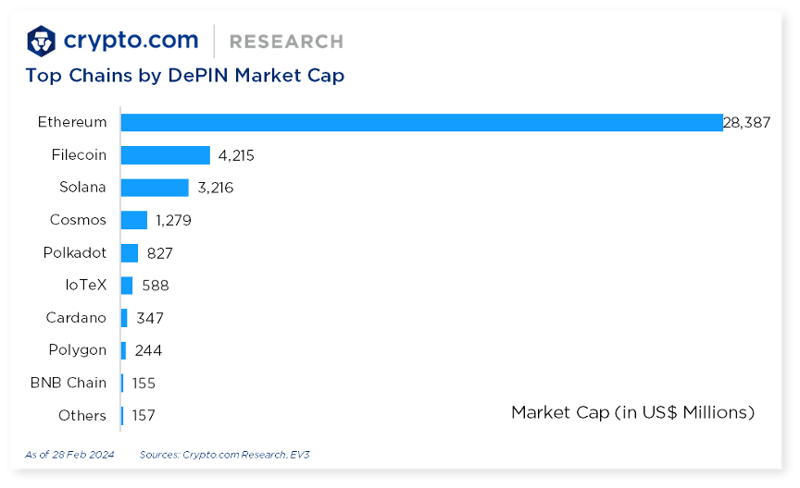The narrative of the DePin (Decentralized Physical Infrastructure Network) theme is becoming increasingly intense within the crypto markets, pushing investors to search for the best projects of the moment.
In this article we explore the best DePin projects of the moment, starting from the premises introduced by a recent study by the Crypto.com exchange
All the details below.
Summary
The growing trend of DePin protocols: the study by Crypto.com
In recent months, one of the trends that is capturing part of the attention of the crypto market is that of the so-called “Decentralized Physical Infrastructure Network“, or rather DePin projects.
These are protocols that generally work through a native token, which is used to incentivize the construction of physical blockchain infrastructures connected to the real world.
Basically, these tokens are used as a form of payment for node operators who provide access to a range of services such as storage space, bandwidth, sensors, and other physical devices or unused resources.
At the same time, those who use these services pay node operators through the same cryptocurrency, incentivizing the creation of a decentralized, open, and self-sufficient economy of scale.
A recent study on the DePin projects market, published by Crypto.com’s internal research branch, helps us clarify the state of this sector niche and its overall outlook.
Currently, the market capitalization of DePin tokens amounts to 25 billion dollars, divided among the sub-categories of data processing, storage, and artificial intelligence.
The latter enjoys the largest market share, also driven by the recent wave of investor enthusiasm across the entire chip and AI sector, which is monopolizing the flow of capital in the markets after the release of Nvidia‘s quarterly data.

Shifting the focus from tokens, and concentrating more on the underlying technology, we can distinguish the myriad of DePin projects that are born every day in two main macro-categories: physical resource networks (based on sensors, wireless systems, and physical devices) and digital resource networks (computing and data storage).
Those with more success fall into the second category, especially in the field of data storage, for which new needs emerge every day as the use of data in everyday life becomes increasingly massive.
In terms of ownership and exposure on the blockchain, we can say that the Ethereum network represents the preferred place for the development of these applications, followed by Filecoin, Solana, Cosmos and Polkadot.
Also worth mentioning is the IoTeX chain, which is building an infrastructure dedicated exclusively to the Internet of Things (IoT).

Industry-leading projects: Helium and Render
Within the same studio led by Crypto.com we find the reference to two major DePin projects, which represent the best solutions on the market, both in terms of native token capitalization and in terms of development of the underlying technology: we are talking about Helium and Render Network.
In particular, we can describe Helium as the largest blockchain infrastructure operating on a wireless physical network.
The project, originally developed on Solana and then migrated to a proprietary chain, works thanks to an organization of users who autonomously and arbitrarily implement wireless networks under the incentive of an economic nature thanks to the HNT token.
This is used as a payment resource for all those who install a physical wireless device (called a hotspot) around the world, through which other users can connect via other hardware, contributing to the creation of a long-range geographical network (LoRaWAN) and 5G connectivity, on which various IoT services can be implemented IoT.
The blockchain underlying helium uses the Proof-of-Coverage (PoC) consensus algorithm to reward participants for verifying network coverage through HNT tokens.
Render Network is, instead, a platform built on top of the Ethereum blockchain, which uses a decentralized GPU processing model to develop real-time rendering services.
The RNDR token is distributed to network operators through a business model similar to that of Helium, incentivizing data flow and the growth of computing power through GPUs.
Currently, the waiting list to become a Render node operator is 100,000 individuals, as this DePin network is one of the most well-known and profitable in the world.
The ultimate goal of the project is to improve rendering speed for digital artists, reduce network transaction costs, and efficiently scale the internet to offer an unprecedented user experience.
According to the data published by Crypto.com, the number of nodes as well as the demand for new scene renders has experienced a strong increase starting from May 2021.

The best DePin crypto projects of the moment: Over, Io.net, Stratos Network
After Helium and Reneder, among the best DePin projects at the moment we find the names of Over and Io.net.
Going in chronological order, we can talk about Over as an augmented reality project developed by Italians on the Ethereum, BNB chain, and Polygon blockchains, focused on the creation of a detailed 3D map of physical locations on which to build virtual interactions.
At the center of this idea is the OVR token, which is used to purchase a digital space (NFT) representing its physical geolocated counterpart.
Those who maintain ownership of these spaces have the right to develop immersive experiences, visible publicly to anyone through the use of a simple smartphone and the Over application.
The same properties can also be openly sold in a marketplace, always through payments in OVR tokens.
In total, this DePin project has 1.2 million registered users globally and, with the help of their smartphone sensors, a dedicated network of mappers has captured more than 14 million geolocated images.
Overall, since its inception, the Over team has made the enormous effort to store 36 TB of data by creating over 28,000 OVRmaps and covering a land area of approximately 9 million square meters.
Without a shadow of a doubt, this is one of the most interesting and innovative DePin solutions compared to all those on the market.
Re-imagine the world with Over the Reality's groundbreaking feature!
— Over the Reality 🌐 (@OVRtheReality) February 22, 2024
Map out locations and place virtual objects precisely in real-world spaces.
Ideal for marketing experiences, creating augmented reality art installations, setting up interactive experiences, and more… Your… pic.twitter.com/8GG9W5Cl96
Io.net is instead a DePin project built on the Solana blockchain, focused on the supply of computing power through GPUs, aggregating resources to offer artificial intelligence (AI) and machine learning (ML) tools to private companies.
This protocol, as described by the cryptographic community, has the power to democratize GPU computing, providing free access to this technology, without any distinctions.
The project is based on the assumption that in the future, to power the large number of AI applications coming, a huge computing power will be needed, which is still underestimated by market analysts.
Io.net does not yet have a token that can incentivize the widespread use of GPUs, but the team of this group has announced that it will release it in the future with the ticker IO.
In this regard, the project recently secured a Series A funding of 30 million dollars managed by Hack VC, Multicoin Capital, and other Ventures.
The developer DePin, who is about to become one of the best on the market, has reached a symbolic valuation of 1 billion dollars after the latest round, preparing to make his debut in the crypto exchanges with the new currency.
BREAKING: https://t.co/WLXlHkvE4z has raised $30M to build the largest decentralized GPU network in the world and solve the AI compute shortage.
— io.net (@ionet_official) March 5, 2024
The Series A round was led by Hack VC with participation from Multicoin Capital, 6th Man Ventures, M13, Delphi Digital, Solana Labs,…
 en.cryptonomist.ch
en.cryptonomist.ch
